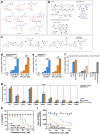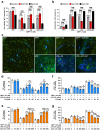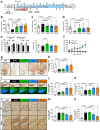An optimized Nurr1 agonist provides disease-modifying effects in Parkinson's disease models
- PMID: 37463889
- PMCID: PMC10354055
- DOI: 10.1038/s41467-023-39970-9
An optimized Nurr1 agonist provides disease-modifying effects in Parkinson's disease models
Abstract
The nuclear receptor, Nurr1, is critical for both the development and maintenance of midbrain dopamine neurons, representing a promising molecular target for Parkinson's disease (PD). We previously identified three Nurr1 agonists (amodiaquine, chloroquine and glafenine) that share an identical chemical scaffold, 4-amino-7-chloroquinoline (4A7C), suggesting a structure-activity relationship. Herein we report a systematic medicinal chemistry search in which over 570 4A7C-derivatives were generated and characterized. Multiple compounds enhance Nurr1's transcriptional activity, leading to identification of an optimized, brain-penetrant agonist, 4A7C-301, that exhibits robust neuroprotective effects in vitro. In addition, 4A7C-301 protects midbrain dopamine neurons in the MPTP-induced male mouse model of PD and improves both motor and non-motor olfactory deficits without dyskinesia-like behaviors. Furthermore, 4A7C-301 significantly ameliorates neuropathological abnormalities and improves motor and olfactory dysfunctions in AAV2-mediated α-synuclein-overexpressing male mouse models. These disease-modifying properties of 4A7C-301 may warrant clinical evaluation of this or analogous compounds for the treatment of patients with PD.
© 2023. The Author(s).
Conflict of interest statement
W.K., M.T., S.V., S.K.K., R.K., A.T., D.S.R., and K.-S.K. are co-inventors of a pending U.S. utility patent application no. 18/013,155 that is assigned to the McLean Hospital Corporation and the University of Delhi. The patent application no. 18/013,155 describes and claims compounds including SPV-94 (4A7C-301) that are described in this manuscript and methods of using these compounds to treat neurodegenerative diseases. K.-S.K. is a co-founder of NurrOn Pharmaceutical, Inc., which has rights to develop compounds disclosed in this manuscript under a licensing agreement with The McLean Hospital Corporation. The remaining authors have no conflicts of interest.
Figures





Similar articles
-
Nuclear receptor Nurr1 agonists enhance its dual functions and improve behavioral deficits in an animal model of Parkinson's disease.Proc Natl Acad Sci U S A. 2015 Jul 14;112(28):8756-61. doi: 10.1073/pnas.1509742112. Epub 2015 Jun 29. Proc Natl Acad Sci U S A. 2015. PMID: 26124091 Free PMC article.
-
Nurr1 and Retinoid X Receptor Ligands Stimulate Ret Signaling in Dopamine Neurons and Can Alleviate α-Synuclein Disrupted Gene Expression.J Neurosci. 2015 Oct 21;35(42):14370-85. doi: 10.1523/JNEUROSCI.1155-15.2015. J Neurosci. 2015. PMID: 26490873 Free PMC article.
-
NURR1 in Parkinson disease--from pathogenesis to therapeutic potential.Nat Rev Neurol. 2013 Nov;9(11):629-36. doi: 10.1038/nrneurol.2013.209. Epub 2013 Oct 15. Nat Rev Neurol. 2013. PMID: 24126627 Review.
-
Hypoxia-inducible factor 1 alpha and nuclear-related receptor 1 as targets for neuroprotection by albendazole in a rat rotenone model of Parkinson's disease.Clin Exp Pharmacol Physiol. 2019 Dec;46(12):1141-1150. doi: 10.1111/1440-1681.13162. Epub 2019 Sep 9. Clin Exp Pharmacol Physiol. 2019. PMID: 31408200
-
The lifelong maintenance of mesencephalic dopaminergic neurons by Nurr1 and engrailed.J Biomed Sci. 2014 Apr 1;21(1):27. doi: 10.1186/1423-0127-21-27. J Biomed Sci. 2014. PMID: 24685177 Free PMC article. Review.
Cited by
-
Lipid-based nanoparticles for drug delivery in Parkinson's disease.Transl Neurosci. 2024 Dec 3;15(1):20220359. doi: 10.1515/tnsci-2022-0359. eCollection 2024 Jan 1. Transl Neurosci. 2024. PMID: 39654878 Free PMC article. Review.
-
Nr4a2, A Key Factor Controlling the Development and Functional Maintenance of Forebrain Car3 Neurons.Neurosci Bull. 2025 Sep 8. doi: 10.1007/s12264-025-01496-z. Online ahead of print. Neurosci Bull. 2025. PMID: 40921971
-
Identification and Validation of Inverse Agonists for Nuclear Receptor Subfamily 4 Group A Member 2.ACS Omega. 2025 Aug 18;10(34):39272-39282. doi: 10.1021/acsomega.5c06698. eCollection 2025 Sep 2. ACS Omega. 2025. PMID: 40918324 Free PMC article.
-
Subtle behavioral alterations in the spontaneous behaviors of MPTP mouse model of Parkinson's disease.Transl Psychiatry. 2025 Apr 3;15(1):119. doi: 10.1038/s41398-025-03312-8. Transl Psychiatry. 2025. PMID: 40175343 Free PMC article.
-
Development of Nurr1 agonists from amodiaquine by scaffold hopping and fragment growing.Commun Chem. 2024 Jun 29;7(1):149. doi: 10.1038/s42004-024-01224-0. Commun Chem. 2024. PMID: 38951694 Free PMC article.
References
Publication types
MeSH terms
Substances
Grants and funding
LinkOut - more resources
Full Text Sources
Other Literature Sources
Medical

